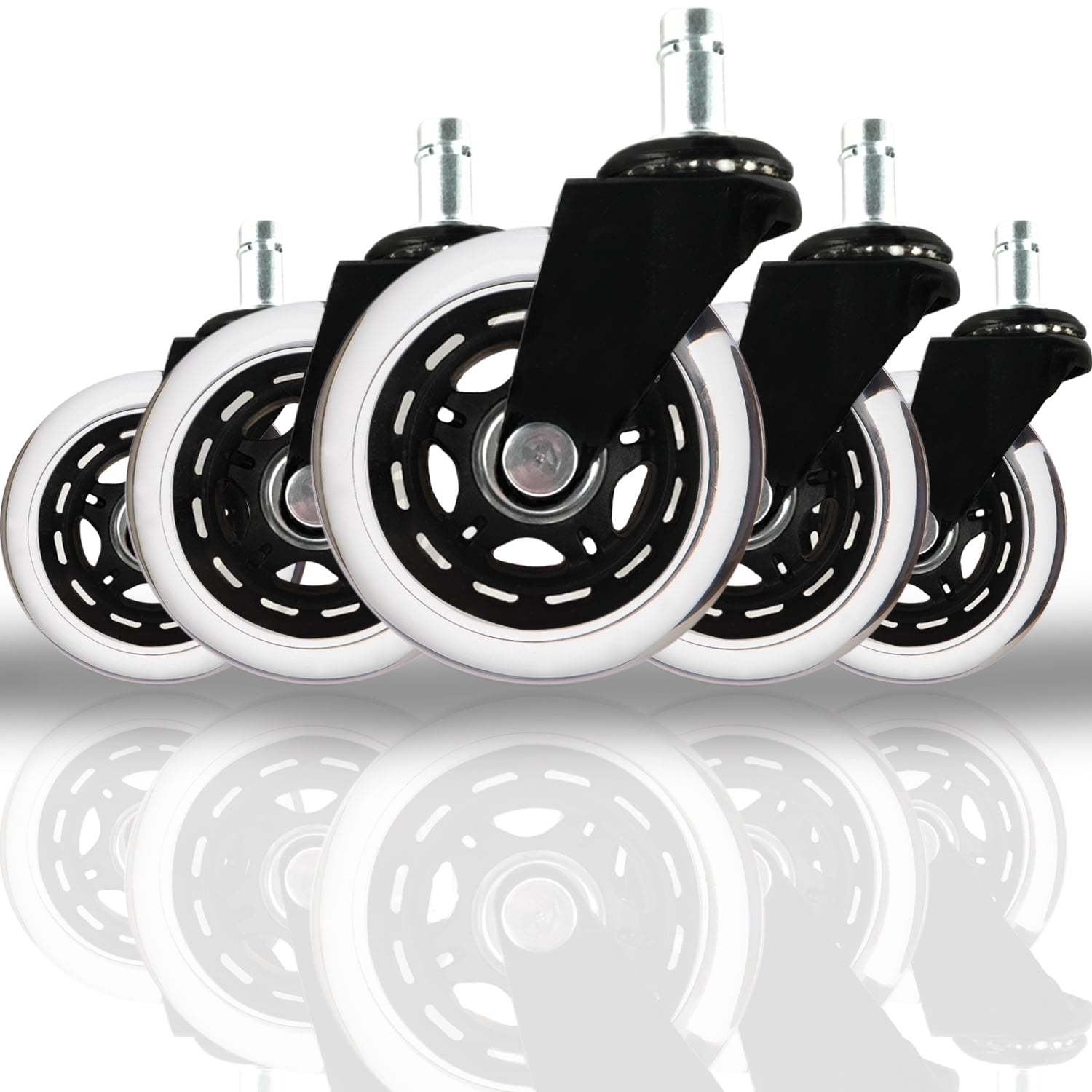Rollerblade Wheel Casters

Rollerblade wheel casters, also known as inline skate casters, offer a unique approach to desk chair mobility, leveraging the principles of inline skating technology for enhanced maneuverability and smoothness. Their design and functionality differ significantly from traditional caster types, presenting both advantages and disadvantages depending on the specific application and user needs.
Engineering Principles and Materials
Rollerblade wheel casters utilize a series of small, closely spaced wheels arranged in a single line, mimicking the wheel setup of inline skates. This design allows for a more streamlined movement, reducing friction and enhancing maneuverability compared to traditional single-wheel casters. The wheels are typically made from polyurethane or nylon, materials chosen for their durability, resilience, and smooth rolling characteristics. Polyurethane offers superior shock absorption and a quieter roll, while nylon provides excellent strength and resistance to wear, albeit potentially with slightly increased noise. The frame holding the wheels is usually constructed from durable plastic or metal, depending on the intended load capacity and overall design. Precision bearings within each wheel further contribute to the smooth operation.
Performance Comparison of Caster Types
The following table compares the performance characteristics of rollerblade casters against standard and ball-bearing casters.
| Caster Type | Smoothness | Maneuverability | Durability |
|---|---|---|---|
| Rollerblade | Excellent, especially on smooth surfaces. Reduced friction due to multiple small wheels. | Excellent, allows for easy directional changes and precise movements. | Moderate to High, depending on material quality and usage. Vulnerable to debris and uneven surfaces. |
| Standard Caster (Single Wheel) | Good on smooth surfaces, but can be bumpy on uneven floors. | Fair, less agile than rollerblade casters. | High, generally robust and long-lasting. |
| Ball-Bearing Caster | Excellent, very smooth rolling due to ball bearings. | Good, but less agile than rollerblade casters. | High, very durable and reliable. |
Size and Load Capacity Considerations, Rollerblade wheel casters desk chair
Rollerblade wheel casters come in various sizes and load capacities. Smaller casters are typically lighter and more maneuverable but may offer lower load capacities, potentially compromising stability for heavier users or chairs. Larger casters, on the other hand, usually support greater weight but might be less agile. For instance, a caster with a 50mm wheel diameter and a 100kg load capacity would be suitable for a heavy-duty office chair, while a smaller 35mm caster with a 60kg capacity might be more appropriate for a lighter chair. The relationship between caster size, load capacity, and chair stability is crucial. Overloading a caster can lead to instability and potential damage, while undersized casters might feel unstable even with a light load. Therefore, selecting casters with appropriate specifications for the chair’s weight and intended use is paramount for optimal user experience and safety.
Maintenance and Troubleshooting of Rollerblade Wheel Casters: Rollerblade Wheel Casters Desk Chair

Rollerblade wheel casters, while offering smooth mobility for desk chairs, require regular maintenance to ensure longevity and optimal performance. Neglecting this can lead to various problems, impacting both the chair’s functionality and user experience. This section details common issues, provides cleaning and lubrication instructions, and offers a troubleshooting guide to help resolve problems efficiently.
Common Problems with Rollerblade Wheel Casters
Several issues commonly plague rollerblade wheel casters on desk chairs. These problems often stem from dust accumulation, lack of lubrication, or damage to the caster components. Understanding these issues is the first step toward effective maintenance.
- Sticking: Casters may become stuck due to debris, dirt, or dried lubricant accumulating in the moving parts. This restricts movement and makes the chair difficult to roll.
- Squeaking: A high-pitched squeaking noise usually indicates a lack of lubrication or friction between the moving parts of the caster.
- Broken Components: Wheels can crack or break due to heavy loads, impacts, or wear and tear. The caster’s internal mechanisms, such as bearings, can also become damaged, leading to impaired functionality.
- Uneven Rolling: One or more casters may roll unevenly, causing the chair to wobble or move erratically. This is often caused by damage to a wheel or an issue with the caster’s internal mechanisms.
Cleaning and Lubricating Rollerblade Casters
Regular cleaning and lubrication are crucial for maintaining the smooth operation of rollerblade casters. This preventative measure can significantly extend the lifespan of the casters and prevent many common problems.
- Preparation: Gather your supplies: a soft brush, a damp cloth, a mild detergent (optional), and a suitable lubricant (such as silicone spray or a light machine oil). Ensure the chair is lifted or tilted to allow access to the casters.
- Cleaning: Use the soft brush to remove loose dirt and debris from around the caster wheels and stems. If necessary, use a damp cloth with a mild detergent to wipe away stubborn grime. Thoroughly dry the casters before proceeding.
- Lubrication: Apply a small amount of lubricant to the moving parts of the caster. This usually involves spraying or applying the lubricant to the wheel bearings and the stem where it connects to the chair base. Avoid over-lubrication, as excess lubricant can attract more dirt.
- Testing: After lubrication, test the casters to ensure they roll smoothly and quietly. If necessary, repeat the cleaning and lubrication process.
Troubleshooting Guide for Rollerblade Wheel Casters
This table provides a systematic approach to identifying and resolving common problems associated with rollerblade wheel casters.
| Problem | Possible Cause | Solution | Prevention |
|---|---|---|---|
| Sticking Casters | Dust, debris, dried lubricant | Clean and lubricate the casters. | Regular cleaning and lubrication. |
| Squeaking Casters | Lack of lubrication, friction | Apply lubricant to moving parts. | Regular lubrication. |
| Broken Wheel | Heavy load, impact, wear and tear | Replace the damaged wheel. | Avoid overloading the chair, use chair mats to protect casters. |
| Uneven Rolling | Damaged wheel, internal mechanism issue | Inspect and replace damaged components. | Regular inspection, avoid rough surfaces. |
